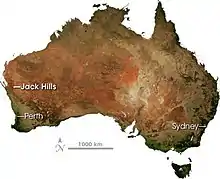.jpg.webp)

The Jack Hills are a range of hills in Mid West Western Australia. They are best known as the source of the oldest material of terrestrial origin found to date: Hadean zircons that formed around 4.404 billion years ago. These zircons have enabled deeper research into the conditions on Earth in the Hadean eon. In 2015, "remains of biotic life" were found in 4.1 billion-year-old rocks there.[1][2] According to one of the researchers, "If life arose relatively quickly on Earth ...then it could be common in the universe."[1]
Geography
They are located on the border of the Shire of Murchison and the Shire of Meekatharra, south of the Murchison River, about 800 kilometres (500 mi) north of Perth.
Geology
The Jack Hills are located in the Narryer Gneiss Terrane of the Yilgarn Craton, Western Australia, and comprise an 80 kilometres (50 mi) long northeast-trending belt of folded and metamorphosed supracrustal rocks.[3]
Sedimentary siliciclastic rocks, interpreted as alluvial fan-delta deposits, are the major lithology. Minor mafic/ultramafic rocks and banded iron formation (BIF) are also found in the sequence. The overall sequence is generally considered to be a granulite gneiss, which has undergone multiple deformations and multiple metamorphic episodes. The protolith age of the Narryer Gneiss Terrane is variable, but generally considered to be in excess of 3.6 Ga (billion years).
Oldest zircons on Earth
_2.jpg.webp)
Detrital zircons with ages greater than 4 billion years old have been found in these rocks, and a 4,404 ± 8 million year old zircon was found at Erawandoo Hill;[4] this is the oldest dated material originating on Earth; the date is in the Cryptic era of the Hadean eon. They were found within a unit of the supracrustal sequence, a metamorphosed conglomerate considered to have an age ~3.0 Ga. Given the detrital nature of the rock unit, the zircons are sourced from pre-existing rocks which were then weathered and the resultant sediment deposited as sedimentary rock.[5]
The zircons and various aspects of their geochemistry provide evidence for the existence of continental-type crust on the surface of Earth during the Hadean eon, contrasting with earlier ideas on the earliest phase of Earth's history. Additionally, oxygen isotopic ratios in the zircons provide evidence for the presence of liquid water on the surface, if not a water ocean;[6] also contrasting with earlier ideas on Earth's history. The hypothesis of humid and cool conditions before the Late Heavy Bombardment has been promoted as cool early Earth.
Economic geology
The Jack Hills banded iron formation (BIF) is the site of a non-operating minor iron ore mine owned by Mitsubishi Development Pty Ltd, a wholly owned subsidiary of Mitsubishi Corporation, which in the past exported up to 3 million tonnes per annum of high grade detrital hematite iron ore via the port of Geraldton.[7][8]
Other companies operating in the area are also planning major magnetite BIF-based iron ore mines.[9]
Conservation
Because of their importance as a geology research site, the Jack Hills were nominated to the Register of the National Estate in 2003. As of 2009, they had an "Interim Listing", which means they have been formally proposed for inclusion in the Register.[10] In July 2020 it was announced that the Erawondoo Hill site has been permanently included in the National Heritage List.[11]
IUGS geological heritage site
In respect of being the 'largest in situ repository of the oldest terrestrial crystals known to exist on Earth', the International Union of Geological Sciences (IUGS) included the 'Archean zircons of Erawondoo Hill' in its assemblage of 100 'geological heritage sites' around the world in a listing published in October 2022. The organisation defines an IUGS Geological Heritage Site as 'a key place with geological elements and/or processes of international scientific relevance, used as a reference, and/or with a substantial contribution to the development of geological sciences through history.'[12]
See also
References
- 1 2 Borenstein, Seth (19 October 2015). "Hints of life on what was thought to be desolate early Earth". Associated Press. Retrieved 9 October 2018.
- ↑ Bell, Elizabeth A.; Boehnike, Patrick; Harrison, T. Mark; et al. (19 October 2015). "Potentially biogenic carbon preserved in a 4.1 billion-year-old zircon" (PDF). Proc. Natl. Acad. Sci. U.S.A. Washington, D.C.: National Academy of Sciences. 112 (47): 14518–21. Bibcode:2015PNAS..11214518B. doi:10.1073/pnas.1517557112. ISSN 1091-6490. PMC 4664351. PMID 26483481. Retrieved 2015-10-20. Early edition, published online before print.
- ↑ "Western Australia's Jack Hills". NASA Earth Observatory newsroom. Archived from the original on 2006-10-01. Retrieved 2006-04-28.
- ↑ Wilde, Simon A.; Valley, John W.; Peck, William H.; Graham, Colin M. (January 2001). "Evidence from detrital zircons for the existence of continental crust and oceans on the Earth 4.4 Gyr ago" (PDF). Nature. 409 (6817): 175–178. doi:10.1038/35051550. PMID 11196637. S2CID 4319774.
- ↑ "Zircons are Forever". Archived from the original on 2007-04-12. Retrieved 2007-04-28.
- ↑ Lindsey, Rebecca (1 March 2006). "Ancient Crystals Suggest Earlier Ocean". NASA Earth Observatory. Retrieved 2015-08-26.
- ↑ "Jack Hills". Australian Mine Sites (A-Z). Perth, Western Australia: Mining Oil Gas Pty Ltd. 2013. Archived from the original on 14 January 2015. Retrieved 14 January 2015.
- ↑ Stevens, Matthew (25 November 2011). "Mitsubishi pays high price for control of Oakajee-Jack Hills iron ore project". The Australian. Retrieved 14 January 2015.
- ↑ "Midwest Resources Conference 2007" (PDF). Midwest Development Corporation. 1 March 2007. Archived from the original (PDF) on 30 August 2007. Retrieved 2007-08-31.
- ↑ "Jack Hills, Cue, WA, Australia (Place ID 18283)". Australian Heritage Database. Australian Government. Retrieved 2009-02-01.
- ↑ "Site of 4.4-billion-year-old mineral fragments receives national protection". www.abc.net.au. 3 July 2020. Retrieved 3 July 2020.
- ↑ "The First 100 IUGS Geological Heritage Sites" (PDF). IUGS International Commission on Geoheritage. IUGS. Retrieved 13 November 2022.
